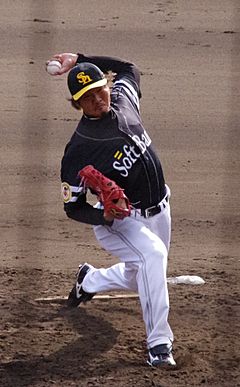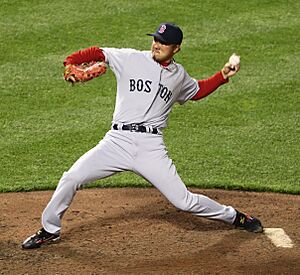Hideki Okajima facts for kids
Quick facts for kids Hideki Okajima岡島 秀樹 |
|||
|---|---|---|---|

Okajima with the Fukuoka SoftBank Hawks
|
|||
| Pitcher | |||
| Born: December 25, 1975 Fushimi-ku, Kyoto, Japan |
|||
|
|||
| Professional debut | |||
| NPB: October 6, 1995, for the Yomiuri Giants | |||
| MLB: April 2, 2007, for the Boston Red Sox | |||
| Last appearance | |||
| MLB: June 13, 2013, for the Oakland Athletics | |||
| NPB: October 2, 2015, for the Yokohama DeNA BayStars | |||
| NPB statistics | |||
| Win–loss record | 38–40 | ||
| Earned run average | 3.19 | ||
| Strikeouts | 760 | ||
| Saves | 50 | ||
| MLB statistics | |||
| Win–loss record | 17–8 | ||
| Earned run average | 3.09 | ||
| Strikeouts | 216 | ||
| Teams | |||
|
|||
| Career highlights and awards | |||
NPB
MLB
|
|||
Hideki Okajima (岡島 秀樹, Okajima Hideki, born December 25, 1975) is a Japanese former professional baseball pitcher. He played for several teams in Japan's Nippon Professional Baseball (NPB) and also in Major League Baseball (MLB) in the United States.
Okajima was chosen for the 2007 Major League Baseball All-Star Game. He was the first Japanese pitcher to play in the World Series in Game 2 of the 2007 World Series. Hideki Okajima announced his retirement from baseball on July 18, 2016.
Contents
Baseball Journey
Hideki Okajima went to Higashiyama High School. He played baseball in the 1994 Koshien National High School Tournament.
Playing for the Yomiuri Giants
The Yomiuri Giants picked Okajima in the third round of the 1993 draft. This team is part of the Nippon Professional Baseball League in Japan.
Okajima often played as a setup man, helping to get the ball to the team's main closer. Sometimes, he even started games until 1999. When he played for the Giants, he used the nickname "Okaji." This was because another famous player, Hideki Matsui, was already on the team.
In 2000 and 2001, Okajima became the team's main closer. A closer is a pitcher who finishes the game, usually in the last inning. He went back to being a setup man in 2002.
Moving to the Hokkaido Nippon-Ham Fighters
Okajima was traded to the Hokkaido Nippon-Ham Fighters just before the 2006 season began. He was a very important left-handed setup pitcher for them. He played in 55 games and had a great ERA (Earned Run Average) of 2.14. The Fighters won the championship that year. In Japan, Okajima had a career record of 34 wins and 32 losses, with a 3.36 ERA.
Time with the Boston Red Sox
In 2006, Okajima became a free agent. He then signed a two-year deal with the Boston Red Sox in the MLB. During spring training in 2007, he was asked about being less famous than his teammate, Daisuke Matsuzaka. Okajima said, "I'm willing to be a hero in the dark."
Okajima gave up a home run on his very first pitch in the major leagues. This was only the eleventh time in MLB history that a pitcher had done this. However, after that, he did not let opponents score for almost two months. He became one of the best relief pitchers in the major leagues. He was named the American League Rookie of the Month for April.
Okajima got his first MLB save on April 20, 2007, against the New York Yankees. He said getting a save in a Red Sox–Yankees game felt like winning the championship.
Even with his success, Okajima stayed pretty unknown in Boston. Once, a taxi driver talked to him and his wife about how great the Red Sox's new lefty pitcher was. The driver did not even know that Okajima was sitting right there!
In Japan, Okajima was known for being serious. But in the United States, he showed his funny side. After pitching in both games of a doubleheader, reporters asked him about facing the same batters twice. He smiled and said, "I did?"
Okajima made the All-Star team after winning the All-Star Final Vote. He was the third Red Sox player to make the team this way. After the All-Star break, he continued to pitch well. However, the long MLB season started to make him tired. He struggled in a game against the Yankees on September 14, 2007. The Red Sox decided to give him a break to rest. When he returned, he pitched well again. He was chosen for the 2007 Topps Major League Rookie All-Star Team.

Okajima pitched great in Game 2 of the 2007 World Series against the Colorado Rockies. He pitched 2⅓ perfect innings, striking out four batters. He became the first Japanese-born pitcher to play in the World Series. He helped the Red Sox win the World Series that year.
On December 3, 2010, the Red Sox let him become a free agent. But they agreed on a new one-year deal on January 2. Okajima did not make the team for Opening Day in 2011. He started the season in Triple-A. He was called up to the Red Sox on April 18. On May 20, 2011, he was removed from the team's main roster. He accepted a move to the Red Sox's Triple-A team.
The New York Yankees signed Okajima to a minor league contract on December 28, 2011. But he did not pass his physical exam at the start of spring training, so he was released.
Return to Japan and Final Years
Okajima signed a one-year contract with the Fukuoka SoftBank Hawks in Japan on February 26, 2012. He left this team on January 29, 2013, to try to play in MLB again.
He signed a minor league deal with the Oakland Athletics on February 11, 2013. He started the 2013 season in Triple-A. He had a 2.16 ERA there. He was called up to the A's main team on May 17, 2013. He was removed from the team on September 3, 2013.
Okajima went back to Japan in 2014. He signed a one-year contract with the Fukuoka SoftBank Hawks again. After the 2014 season, he thought about returning to MLB. Instead, he chose to stay in Japan. He signed with the Yokohama DeNA BayStars in December 2014.
He signed a minor league deal with the Baltimore Orioles in February 2015. He was released on March 31, 2016. Hideki Okajima officially retired from baseball on July 18, 2016.
Pitching Style
Okajima had a very unique way of pitching. Just before he threw the ball, he would turn his head downwards. After he released the ball, he would quickly jerk his head towards third base. These movements seemed to make his pitches faster. They also made it harder for batters to see the ball coming. This caused batters to swing too early.
Okajima said he copied this motion from a pitcher in a Japanese comic book (manga) called Ace!. In the comic, the pitcher turned his head so much that his hat flew off. Okajima admitted, "I was trying to copy the motion. I believed it would make me throw harder."
Some people in Japan called his pitching style "Looking the Other Way." This name came from a local game similar to rock-paper-scissors. At first, many coaches in Japan tried to change Okajima's pitching style. But then, Yoshitaka Katori, a pitching coach for the Yomiuri Giants, accepted his unique way of throwing.
Early in his career, Okajima sometimes had trouble controlling his pitches. After the 2005 season, he was traded to the Hokkaido Nippon Ham Fighters. There, he changed his pitching form and gained much better control.
Okajima's fastballs were not super fast, usually around 85–89 mph. His best pitch in Japan was his "rainbow curveball," which was slower, around 70–75 mph. Left-handed batters found this pitch very hard to hit. He also sometimes threw a circle changeup and a forkball.
After joining the Red Sox, Okajima showed amazing accuracy. His former teammate, Hideki Matsui, was surprised because he never thought Okajima could get such "great control." Okajima's success in MLB was different from his time in Japan. In Japan, he was often used as a "situational lefty." This meant he would come in to face just one left-handed batter in important late-game situations.
In April 2007, a Red Sox pitching coach helped Okajima improve his changeup pitch. The new pitch had a special "screwball" motion. The team's bullpen coach called it the "Okie-Dokie." This pitch was very effective.
Former baseball star Gary Sheffield called Okajima "one of the most impressive lefties I've ever seen." He said Okajima had "stuff I have never seen before from anybody." Former Yankees manager Joe Torre even called Okajima "unhittable."
Personal Life
Okajima looks up to Masumi Kuwata as his "master." Okajima is married to sports announcer Yuka Kurihara (栗原 由佳, Kurihara Yuka). They have three sons and a daughter. He met his wife during a celebration after his Yomiuri Giants team won the 2000 Japan Series.
Okajima enjoys romance movies. Some of his favorite films include Ghost, Pretty Woman, and Autumn in New York.
Okajima also ran the Honolulu Marathon on December 14, 2008. He finished the race in 6 hours, 10 minutes, and 26 seconds.
Awards and Achievements
- Nippon Professional Baseball All-Star Game: 2000, 2001, 2002.
- Japan Series Champion: 2000, 2002 (with Yomiuri Giants), and 2006 (with Hokkaido Nippon Ham Fighters).
- Asia Series Champion: 2006 (with Hokkaido Nippon Ham Fighters).
- American League Rookie of the Month: April 2007.
- American League All-Star: 2007.
- World Series Champion: 2007 (with Boston Red Sox).
See also
- List of Major League Baseball players from Japan


